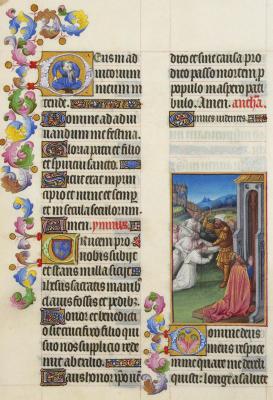Posted on August 1, 2009
Ruling
One of the biggest aesthetic shifts between medieval and modern book layout is ruling. Medieval scribes would draw straight lines on their paper and on their margins to keep their writing straight, much like modern notebook paper. Today, we consider these sorts of guide lines to be juvenile – only children write letters on ruled paper. In the Middle Ages, though, they were not only functional, but considered a part of the book’s aesthetic appeal. In fact, the more expensive and lavish the book, the more ruling it included.
Ruling could be done in several ways. Usually scribes would prick a series of little holes along the very edges of their parchment, evenly spaced. Then they would draw straight lines connecting these little marginal holes. This was a very efficient method, since they could prick holes in a whole stack of parchment. Sometimes the margins with the holes were trimmed off, but often they remain. The lines might just be scored into the parchment with a knife, but with thin parchment this can lead to some unhappy mistakes. Sometimes they would use a lead pencil – not graphite like a modern pencil, but actual lead, which left a faint red line. Sometimes they used ink. Ruling is most commonly done in red, but sometimes they would use a variety of colors.
I really like how rulings look – they add a wonderful visual regularity to a manuscript page. Some rulings go all the way to the edge of the margin, and some do not, and this creates some very interesting boundaries. The marginal art sometimes plays with these boundaries in some fun ways.
Ruling was such an important part of the appearance of a book’s pages that when printing was invented, the printers would sometimes rule a page after it had been printed. Those rulings served no function except to be pretty and make a printed book look fancy.


